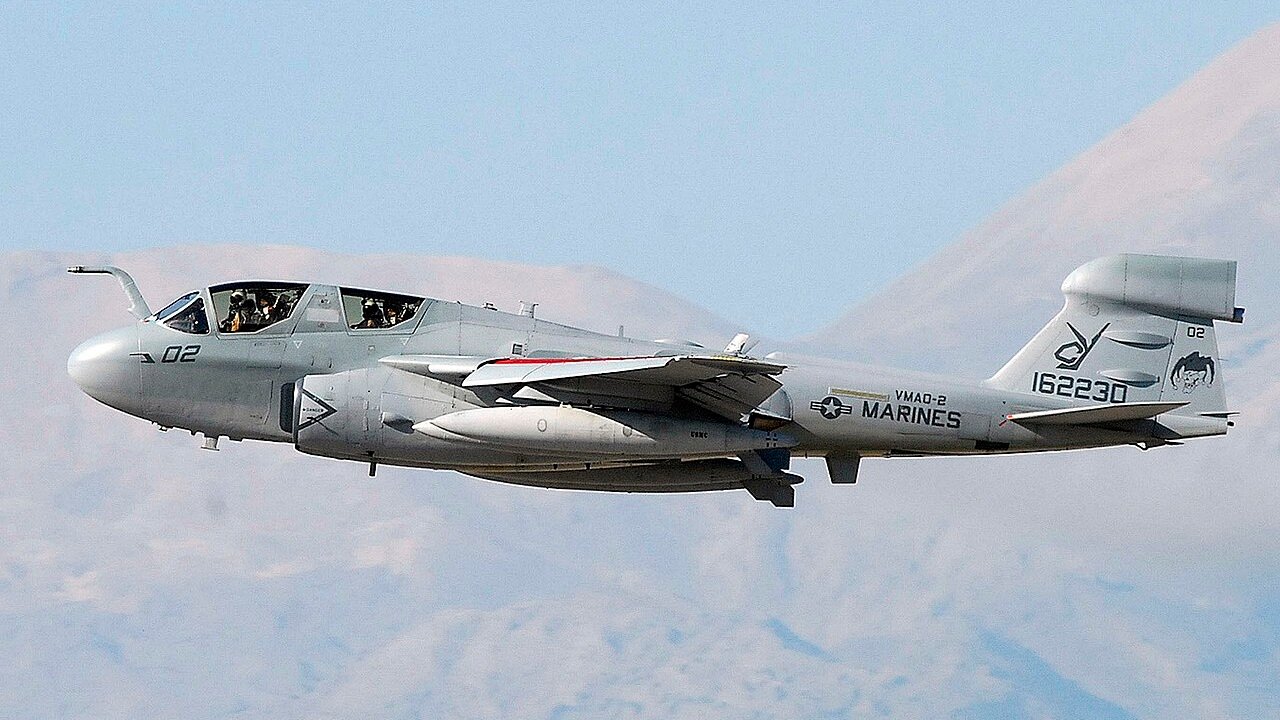The EA-6B Prowler set the very highest standard for electronic warfare, not only in the U.S. military but across the world.
As the United States moved into the Cold War, with aircraft and anti-aircraft systems being developed and advanced by both the Soviet Union and the United States, the need arose for a dedicated electronic warfare platform.
The U.S. military had played around with electronic warfare aircraft that were simple augmentations of other planes, such as the EA-6A Intruder. But in 1971, the country’s first real electronic warfare aircraft entered service: the iconic EA-6B Prowler.
All About the EA-6B Prowler
A twin-engine, four-seat, carrier-based electronic warfare aircraft developed by Northrop Grumman, the Prowler served as the United States Navy’s and Marine Corps’ primary electronic attack aircraft for more than 40 years.
The Prowler was built on the A-6 Intruder airframe, but featured significant modifications to accommodate its electronic warfare mission set. The fuselage was lengthened to house a four-person crew, consisting of a pilot and three electronic countermeasures officers (ECMOs).
Prowlers were equipped with cutting-edge avionics and jamming systems, making it a formidable tool for suppressing enemy air defenses (SEAD)—a key activity for any modern military seeking to strike deep inside enemy territory. Indeed, the Vietnam War—and the need for American bombers to strike inside North Vietnam, with its sophisticated Soviet-provided air defense network—defined the early development and service life of the EA-6B Prowler.
As a robust and versatile aircraft that was designed to operate in a high-threat environment, the Prowler brought speed as well as versatility. Two Pratt & Whitney J52-P-408 turbojet engines powered this plane, providing a maximum speed of 615 miles per hour and a range of around 2,400 miles (with external fuel tanks). Its airframe was optimized for carrier operations, featuring a reinforced structure, folding wings, and an arrestor hook for landings on aircraft carriers.
Electronic Warfare Was the Beating Heart of the Prowler
At the heart of the Prowler’s capabilities was its impressive electronic warfare suite which centered around the AN/ALQ-99 Tactical Jamming System. This system allowed the aircraft to detect, analyze, and jam enemy radar and communication systems across a wide frequency spectrum.
The ALQ-99 could generate powerful electronic noise to blind enemy radar or transmit deceptive signals to confuse targeting systems. The Prowler also carried up to five external pods for the ALQ-99, each tailored to specific frequency bands, giving it unmatched flexibility in countering diverse threats.
In addition to its jamming capabilities, the EA-6B was equipped with the AGM-88 High-Speed Anti-Radiation Missile (HARM), which could home in on—and destroy—enemy radar installations. This combination of active jamming and kinetic strikes made the Prowler a dual-threat platform, capable of both suppressing and eliminating enemy air defenses.
The aircraft’s advanced avionics, including the AN/AYK-14 mission computer and later upgrades like the Improved Capability (ICAP)-II systems, provided enhanced situational awareness and precision targeting. These capabilities ensured the bird’s continued relevance as well as its lethality in highly contested, complex battlefields.
The EA-6B Prowler’s History of Incredible Success
It was not only Vietnam where the EA-6B Prowler saw extensive action. The bird flew in multiple conflicts—and set impressive records in each campaign.
During the Cold War, the Prowler was the cornerstone of the U.S. Navy’s grand strategy for sea control over the Soviets. Its role then expanded in the post-Cold War era, with significant contributions in the Gulf War (1991), where it disrupted Iraqi radar and communications, enabling coalition air forces to dominate the skies.
The Prowler continued to play a pivotal role in subsequent conflicts, including in the Balkans, the 2003 invasion of Iraq, Afghanistan, and Libya.
One of the reasons this bird flew for the Navy and Marines for more than 40 years was its incredible adaptability. This plane evolved along with—and against—rival anti-aircraft systems. From EAD to electronic attack to intelligence gathering—to even the suppression of improvised explosive device (IED) triggers in counterinsurgency missions!—this plane was unstoppable.
2019 marked the end of the Prowler’s incredible service to the United States. At that time, the Navy had fully transitioned to relying upon the Boeing E/A-18G Growler, a derivative of the F/A-18F Super Hornet, while the Marine Corps shifted to ground-based electronic warfare systems and other platforms.
The Prowler set the very highest standard for electronic warfare, not only in the U.S. military but across the world, as many other militaries attempted both to catch up with and outmatch the American Prowler. None could. The EA-6B was key for America’s understanding—and dominance—of the electromagnetic (EM) spectrum in modern combat operations. The hard lessons learned from the 40 years of Prowler operations were applied to the development of the EA-18G Growler.
About the Author: Brandon J. Weichert
Brandon J. Weichert, a Senior National Security Editor at The National Interest as well as a contributor at Popular Mechanics, who consults regularly with various government institutions and private organizations on geopolitical issues. Weichert’s writings have appeared in multiple publications, including the Washington Times, National Review, The American Spectator, MSN, the Asia Times, and countless others. His books include Winning Space: How America Remains a Superpower, Biohacked: China’s Race to Control Life, and The Shadow War: Iran’s Quest for Supremacy. His newest book, A Disaster of Our Own Making: How the West Lost Ukraine is available for purchase wherever books are sold. He can be followed via Twitter @WeTheBrandon.
Image: Wikimedia Commons.
